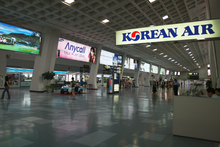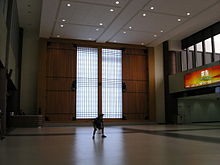Gimpo International Airport: Difference between revisions
→History: added units |
→Korean War: added details of Inchon landings and recapture |
||
| Line 177: | Line 177: | ||
===Korean War=== |
===Korean War=== |
||
Kimpo played a major role during the [[Korean War]] as the US Kimpo Air Base, code named as '''K-14''' |
Kimpo played a major role during the [[Korean War]] as the US Kimpo Air Base, code named as '''K-14'''. |
||
Following the [[Battle of Inchon|Inchon landings]] on 15 September 1950, the [[2nd Battalion 5th Marines]] was ordered to seize Kimpo on 17 September.<ref name="Hoyt">{{cite book|last=Hoyt|first=Edwin P.|title=On to the Yalu|publisher=Stein and Day|year=1984|isbn=0812829778|page=58}}</ref>Kimpo was defended by a conglomeration of half-trained fighting men and service forces and by the morning of 18 September the Marines had secured the airfield. The airfield was in excellent shape as the North Koreans had not had time to do any major demolition.</ref>.<ref name="Hoyt, p. 61">Hoyt, p.61</ref> On 19 September, the [[United States Army Corps of Engineers|U.S. Army Corps of Engineers]] repaired the local railroad up to eight miles (13 km) inland and transport planes began flying in gasoline and ordnance for air operations. |
|||
USAF units based at Kimpo included: |
USAF units based at Kimpo included: |
||
| Line 185: | Line 187: | ||
**[[336th Fighter Squadron|336th Fighter-Interceptor Squadron]] |
**[[336th Fighter Squadron|336th Fighter-Interceptor Squadron]] |
||
*[[8th Fighter Wing|8th Fighter-Bomber Wing]] from 25 June-23 August 1951 |
*[[8th Fighter Wing|8th Fighter-Bomber Wing]] from 25 June-23 August 1951 |
||
*[[67th Network Warfare Group|67th Tactical Reconnaissance Group]] from 20 August 1951-6 December 1954 |
|||
*[[80th Fighter Squadron]] operating P-51s from 27 October-20 December 1950 |
*[[80th Fighter Squadron]] operating P-51s from 27 October-20 December 1950 |
||
The defection of [[North Korean]] pilot [[No Kum-Sok]] and is associated with [[Operation Moolah]]. |
|||
<gallery> |
<gallery> |
||
Revision as of 13:12, 24 June 2013
This article needs additional citations for verification. (July 2009) |
Gimpo International Airport 김포국제공항 金浦國際空港 Gimpo Gukje Gonghang Kimp'o Kukche Konghang | |||||||||||||||
|---|---|---|---|---|---|---|---|---|---|---|---|---|---|---|---|
 Domestic Terminal | |||||||||||||||
| Summary | |||||||||||||||
| Airport type | Public | ||||||||||||||
| Operator | Korea Airports Corporation | ||||||||||||||
| Serves | Seoul | ||||||||||||||
| Standort | Gangseo-gu, Seoul, South Korea | ||||||||||||||
| Hub for | |||||||||||||||
| Elevation AMSL | 58 ft / 18 m | ||||||||||||||
| Website | [1] | ||||||||||||||
| Map | |||||||||||||||
| Runways | |||||||||||||||
| |||||||||||||||
| Statistics (2012) | |||||||||||||||
| |||||||||||||||
Statistics from KAC[1] | |||||||||||||||
Gimpo International Airport (Korean: 김포국제공항), commonly known as Gimpo Airport (IATA: GMP, ICAO: RKSS) (formerly Kimpo International Airport), is located in the far western end of Seoul, some 15 km (9 mi) west of the Central District of Seoul. It was the main international airport for Seoul and South Korea before being replaced by Incheon International Airport in 2001. It is now the second largest airport in Korea after Incheon International Airport.[citation needed] In 2011, 18,513,927 passengers used the airport.
Airlines and destinations
Gimpo Airport primarily serves domestic and limited international flights to Japan, Taiwan, and China.
Traffic and statistics
Top Carriers
In 2012, the ten carriers with the largest percentage of passengers flying into, out of, or through Gimpo International Airport are as follows:
| Rank | Carrier | Domestic Passengers |
International Passengers |
Total | % |
|---|---|---|---|---|---|
| 1 | 4,876,772 | 1,189,804 | 6,066,576 | 31.22% | |
| 2 | 3,202,570 | 1,004,217 | 4,206,787 | 21.65% | |
| 3 | 1,584,560 | 213,353 | 1,797,913 | 9.25% | |
| 4 | 1,576,329 | 27,536 | 1,603,865 | 8.25% | |
| 5 | 1,529,612 | 224 | 1,529,836 | 7.87% | |
| 6 | 1,364,448 | 18,895 | 1,383,343 | 7.12% | |
| 7 | 1,200,356 | 1,200,356 | 6.18% | ||
| 8 | 655,035 | 655,035 | 3.37% | ||
| 9 | 545,250 | 545,250 | 2.81% | ||
| 10 | 101,240 | 101,240 | 0.52% |
Other facilities
The Aviation and Railway Accident Investigation Board (ARAIB) has its FDR/CVR Analysis and Wreckage Laboratory on the property of Gimpo International Airport.[2] When the predecessor agency Korea Aviation Accident Investigation Board (KAIB) existed, its CVR/FDR and wreckage laboratory was located on the airport property.[3]
History


The airfield was orginally constructed in 1939-1942 during the Japanese Imperial period.

Korean War
Kimpo played a major role during the Korean War as the US Kimpo Air Base, code named as K-14.
Following the Inchon landings on 15 September 1950, the 2nd Battalion 5th Marines was ordered to seize Kimpo on 17 September.[4]Kimpo was defended by a conglomeration of half-trained fighting men and service forces and by the morning of 18 September the Marines had secured the airfield. The airfield was in excellent shape as the North Koreans had not had time to do any major demolition.</ref>.[5] On 19 September, the U.S. Army Corps of Engineers repaired the local railroad up to eight miles (13 km) inland and transport planes began flying in gasoline and ordnance for air operations.
USAF units based at Kimpo included:
- 4th Fighter Wing operating F-86s from 23 August 1951-1 October 1954, subordinate units included:
- 8th Fighter-Bomber Wing from 25 June-23 August 1951
- 67th Tactical Reconnaissance Group from 20 August 1951-6 December 1954
- 80th Fighter Squadron operating P-51s from 27 October-20 December 1950
The defection of North Korean pilot No Kum-Sok and is associated with Operation Moolah.
-
Wreckage of a C-54 destroyed on the ground by KPAF fighters on 25 June 1950
-
Captured KPAF Ilyushin Il-10, 21 September 1950
-
No. 77 Squadron RAAF Gloster Meteor in 1952
-
Engine change on an F-86E in 1952
-
MiG-15, September 1953
Postwar
In 1958 was designated as the international airport of the South Korean capital city and has grown into a much more significant airport that is capable of handling 226,000 flights a year. The airport had one domestic and two international terminals before its international function was replaced by Incheon International Airport. Gimpo currently has two runways (3600 m×45 m & 3200 m×60 m), two passenger terminals, and one cargo terminal.
The airport is located south of the Han River in western Seoul. (The name "Gimpo" comes from the nearby city of Gimpo, of which the airport used to be a part.)
On November 29, 2003, scheduled services between Gimpo and Tokyo International Airport (Haneda) in Tokyo, Japan began. Services to Shanghai Hongqiao International Airport started on October 28, 2007. Services to Kansai International Airport In Osaka, Japan started on October 26, 2008. Services to Beijing Capital International Airport started on July 1, 2011.[6]
Airlines that formerly served Gimpo but no longer fly to Korea are listed: Air New Zealand, Alitalia, Ansett Australia, Continental Airlines, Iberia Airlines, Kuwait Airways, Lauda Air, Qantas (now cargo only), Saudia, Swissair, VASP.
Accidents and incidents

- On April 20, 1978, Korean Air Lines Flight 902 a Boeing 707 was shot down by the Soviet Air Force while flying from Paris, France to Anchorage, Alaska and continuing to Gimpo Airport. Two passengers were killed in the Explosive Decompression and the flight was able to land on a frozen lake were the remaining passengers and crew were transported to safety and then flown out of the Soviet Union back to South Korea
- On November 19, 1980, a Korean Air Lines 747 landed short of the runway, ripping off all main landing gear, causing the aircraft to skid to a stop on the nose wheel and outer 2 engines starting a fire. 15 of the 226 total occupants were killed, including the First Officer and Captain.[7]
- On September 1, 1983, Korean Air Lines 007 (a Boeing 747) bound for Seoul from New York City via Anchorage was shot down by a Soviet interceptor jet after pilot error drifted the plane into a restricted soviet air space, all passengers and crew on board were killed as the plane plummeted into the Sea of Japan and escalated tensions between the Soviet Union and the United States.
Ground Transportation
Rail
For many years, the airport was served by the Gimpo Line, a railway line that no longer exists. In the 1990s, Seoul Subway Line 5 was extended to Gimpo. On March 23, 2007, the AREX airport express line started operations to Incheon International Airport, with an extension to Seoul Station which opened in December 2010. Seoul Subway Line 9 also opened which links the airport to the Gangnam area.
See also
- List of the busiest airports in South Korea
- Transportation in South Korea
- Incheon International Airport
- AREX - Airport Railroad
References
- ^ Korean airport statistics
- ^ "Office Location." (Archive) Aviation and Railway Accident Investigation Board. Retrieved on February 15, 2012. "CVR/FDR analysis and wreckage laboratory : Gimpo International Airport 274 Gwahae-dong, Gangseo-gu, Seoul, Korea 157-711"
- ^ "KAIB/AAR F0201." Korea Aviation Accident Investigation Board. 4/168. Retrieved on June 18, 2009. "The main office is located near Gimpo International Airport, and the flight recorder analysis and wreckage laboratories are located inside the airport."
- ^ Hoyt, Edwin P. (1984). On to the Yalu. Stein and Day. p. 58. ISBN 0812829778.
- ^ Hoyt, p.61
- ^ http://www.southkoreanews.net/story.php?rid=44900831
- ^ Aircraft accident Boeing 747-2B5B HL7445 Seoul-Gimpo (Kimpo) International Airport






